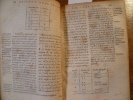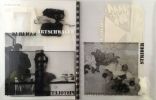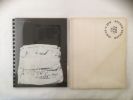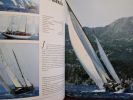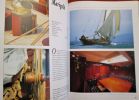73 books for « pace »Edit
-
Type
Book (66)
Music sheets (6)
New book (1)
-
Language
English (1)
French (70)
Italian (2)
-
Century
16th (2)
17th (2)
20th (39)
21st (5)
-
Countries
Belgium (3)
Denmark (1)
France (56)
Italy (2)
Switzerland (10)
United Kingdom (1)
-
Syndicate
CLAM (1)
ILAB (24)
SLAM (18)
Topics
- Adam (1)
- Alcohol (3)
- Ampelography - wines (2)
- Archaeology (1)
- Aristotle (2)
- Biography (1)
- Boats - ships (1)
- Children’s books (2)
- Christianity (1)
- Colette (1)
- Colonies (1)
- Cooking (2)
- Dressmaking (1)
- Drink (2)
- Fine arts (1)
- Franco (4)
- Freemasonry (2)
- Gastronomy (1)
- Geography (1)
- Hermeticism (1)
- Italian (2)
- Jed (1)
- Justice (1)
- Latin (2)
- Law (3)
- Linnean society of lyons (1)
- Literature (1)
- Lyons and area (1)
- Lyons college (1)
- Lyons college pc (1)
- Lyons revue (1)
- Magazine (1)
- Mathematics (2)
- Mushrooms mycology (1)
- Newspapers press (1)
- Pace valentino (1)
- Photography (2)
- Policy (1)
- Poussin nicolas (1)
- Religions (1)
- Religions & spirituality (1)
- Reverend (1)
- Reviews (1)
- Rituals (1)
- Sail (2)
- Scores (5)
- Scout (1)
- Songs (5)
- Tea (1)
- Vietnam (1)
- Viticulture (2)
- Wine (3)
- Woolf virginia (1)
- Zaraï rika (1)
Organon [Greek]. Principis Organum, Hoc est libri omnes ad Logicam pertinentes, Graecè & Latiné. Iul. Pacius recensuit: è Graeca in Latinam linguam conuertit: capitum & particularum distinctionibus, argumentísque: praeterea variis lectionibus, necno p... - [THE STANDARD INTERPRETATION OF ARISTOTLE'S ""ORGANON""]
Morgiis, Guillelmus Laimarius, 1584. Small folio. 18th century half vellum, somewhat soiled and worn. Corners and edges bumped and worn. Handwritten title to spine. Fore-edge with 2-line title in neat (contemporary?) hand and with the ""Societas Jesu"" (i.e. the Jesuit Society) symbol in white to the otherwise red fore-edge. Internally a very ni8ce copy, with the occasional browning and spotting. A faint damp stain to top marging of some leaves. A small hole to top of title-page, far from affecting print. Last leaves with neat strenthening of blank upper corners, far from affecting text. Old (presumably 18th century) owner's name to title page: ""Ioan. Bey A. Vest."" Front free end-papers heavily annotated (presumably by this same owner, in Latin, Greek, and German. The annotations include and elaborate handwritten index, information about the edition, and references to the Greek sentences. Verso of last leaf and back end-papers also with notes. A few underlinings here and there. Woodcut ornamental title-border, woodcut vignettes, woodcut initials, numerous woodcut illustrations and diagrams in the text. Greek-Latin parallel-text. (8), 831, (1) pp.
The very rare first edition of Julius Pace's seminal ""Organon""-edition, which was the standard-edition of the logical texts of Aristotle throughout more than a century, running through at least 11 editions before 1624. Pace's version of the text, in Greek-Latin parallels, and with Pace's inspired commentaries and interpretations, profoundly influenced Renaissance thought, determining the course of the Organon-interpretation throughout this period and inspiring much original philosophical thought. Pace's interpretation of Aristotle's logical works - arguably the most influential collection of works in the history of Western thought - not only changed the face of Renaissance thought, it has remained the authoritative reading of Aristotle's ""Organon"" to this day and is still considered the most important and authoritative reading of the texts. As Ross puts it in the Preface to his translation of the logical works (the standard Oxford-edition): ""My chief authority in matters of interpretation has been Pacius"". (""The Works of Aristotle Translated into English Under the Editorship of W.D. Ross. Volume I"". Oxford University Press). To this day, a proper study of Aristotle's ""Organon"" - and Porphyrios' ""Isagoge"" - is still unthinkable without references to Pace, his rendering of the text, and his interpretations of it. The famous ""Porphyrian Tree"" or ""arbor porphyriana"", which has gone down in history as a standard presentation of the basis of Aristotle's thought, was presented by Porphyrios in his ""Isagoge"", which since Antiquity has accompanied Aristotle's ""Ornanon"" as an introduction thereof. The standard presentation of this tree is that of Pace in the present edition, on p. 9. It is that rendering of it, with occasional slight alterations, which has remained standard ever since 1584. That which we ever since Antiquity have called the ""Organon"" comprises the logical works of Aristotle: 1. Categories, 2. On Interpretation, 3. Prior Analytics, 4. Posterior Analytics, 5. Topics, 6. On Sophistical Refutations - which ever since late Antiquity/early Middle Ages have been accompanied by Porphyrios' (233/34-ca.310) ""Isagoge"", his introduction to Aristotle's ""Categories"". During the Renaissance, all editions of Aristotle's ""Organon"" also comprised Porphyrios' ""Isagoge"", which was seen as necessary for the understanding of Aristotle's logic. Aristotle's logic has played a seminal role in the history of Western thought. No other collection of writings has had an impact on the history of philosophy that comes close to the ""Organon"", an impact that remains pivotal to this day. ""Aristotle's logic, especially his theory of the syllogism, has had an unparalleled influence on the history of Western thought."" (SEP).From Antiquity, the earlier middle ages had inherited Boethius' translation of the two first treatises of Aristotle's ""Organon"", along with Porphyrios' ""Isagoge"". These works formed the basis for logical study and teaching until the end of the 11th century. Only during the 12th and 13th centuries, were Aristotle's writings - along with those of the Arabic and some of the Greek commentators - translated into Latin. When the medieval universities reached their full development during the thirteenth century, Aristotle's works were adapted as the standard textbooks for all philosophical disciplines - thus modern terms for many philosophical and scientific disciplines correspond to the titles of Aristotle's works (e.g. Ethics, Physics, Metaphysics). Through Aristotle's works, the West thus acquired, not only the specific problems and ideas that were being dealt with at the universities, but also the terminology used to describe and discuss them and the systematic framework within which all relevant problems should and could be treated. But come the Renaissance, we see a clear change in the use of Aristotle's works. We here witness something other than a mere continuation of the late medieval Aristotelianism. The Humanists began supplying new translations of Aristotle's works and translated all the Greek commentators of Aristotle, many of them for the first time. And thus, a tendency to emphasize the original Greek Aristotle developed, a tendency that became pivotal for the development of modern thought - the development of modern science and modern philosophy is inextricably linked with the Renaissance Humanist editions of Aristotle's works in Greek (with Latin parallel-text). The ""Organon"", Aristotle's seminal logical writings, occupies a central position within the Aristotelian body of writing and thus within the development of Western thought. Certain Humanist versions of the Greek text and the Latin translations, as well as the interpretations of them, thus came to play a seminal role in the trajectory of Renaissance and modern though, Pace's ""Organon""-edition presumably being THE most important and influential edition ever to have appeared. ""The medieval traditions of logical writing survived well into the sixteenth century particularly at Paris and at the Spanish universities, though with considerable internal changes. Treatises on sophisms and on proofs of terms ceased to be written"" whereas there was a sudden flurry of activity concerned with the various divisions of terms and with the opposition of propositions, i.e. the logical relations between different kinds of categorical proposition. These internal changes were not, however, sufficient to keep the tradition alive, and after about 1530 not only did new writing on the specifically medieval contributions to logic cease, but the publication of medieval logicians virtually ceased. The main exceptions were the logical commentaries by (or attributed to) such authors as Thomas Aquinas and John Duns Scotus, which found a place in their ""Opera Omnia"", and which benefited from a revived interest in the great medieval metaphysicians.The main changes in the teaching and writing of logic during the sixteenth century were due to the impact of humanism. First, commentaries on Aristotle came to display a totally new style of writing. One reason for this was the influence of new translations of Aristotle, and new attitudes to the Greek text. Another reason was the publication of the Greek commentators on Aristotle's logic, Alexander, Themistius, Ammonius, Philoponus and Simplicius. A third reason was the new emphasis on Averroes, which expressed itself in the great Aristotle-Averroes edition of 1550-1552. The effects of these new factors can be seen in the commentaries on individual works of the ""Organon"" by such Italians as Agostino Nifo (1473-1546) and Jacopo Zabarella (1533-1589), the latter of whom offered a particularly influential account of scientific method. They can also be seen in the ""Organon"" edition of Giulio Pace (1550-1635), which was first published in 1584 and contained the Greek text side-by-side with a new translation which was designed not only to read well but also to capture the philosophical significance of Aristotle's words."" (Raul Corazzon, ""History of Renaissance and Modern Logic from 1400 to Stuart Mill"").""No editor better understood the nature of this Treatise of Aristotle than Julius Pacius, who was the preceptor of Casaubon, and profoundedly skilled in all the arcane of the Peripatetic philosophy, in both the Greek and Latin tongues."" (Dibdin I: 318)Giulio Pace of Beriga (or Julius Pace/Pacius) (1550 - 1635) was a famous Italian Aristotelian scholar and jurist. He was born in Vicenza and studied law and philosophy in Padua. He was inspired by the Reformation and put on trial by the Inquisition. Therefore he had to flee Italy and escaped, first to Geneva, thereafter to Germany. While in Heidelberg, he converted to Protestantism. He was highly respected as an academic and was widely known for his deep knowledge and understanding of Aristotle, whom he became famous for translating. He was elected public professor in Geneva, where he taught for ten years (1575-1585). The next ten years he spent teaching law at the University of Heidelberg (where he got into different conflicts, especially with the philosophical faculty for giving private tuition in the controversial Ramist logic). After Heidelberg, he taught at different universities throughout Europe, where he was especially well known for his 1584-edition of Aristotle's ""Organon"", which played a definitive role in Aristotle-scholarship and philosophy in general throughout all of Europe.Dibdin I:318" Adams A:1866.
L'Organon (titre en grec)Aristotelis stagiritae peripateticorum principis Organum Hoc est, libri omnes ad Logicam pertinentes, Graece et Latine. Ivl. Pacius a Beriga interprete [...]
Hanovia, Typis wechelianis, apud Claudium, M. DC. VI. (1606)Un volume relié (10,5 x 16,5 cm) de 6ff - 951 pages. Reliure plein vélin à rabats, dos lisse, titrage manuscrit à l'encre au dos. Reliure légèrement salie et usée, des rousseurs sinon bon exemplaire.Impression sur deux colonnes de l'Organon d'Aristote dans la version établie en grec et traduite en latin par l'humaniste italien Giulio Pace. Elle avait été imprimée pour la première fois en 1584. L'Organon rassemble toutes les oeuvres d'Aristote ayant trait à la logique : l'Éloge de Porphyre, les Catégories, De l'Interprétation, les Analytiques, les Topiques, la Réfutation des Sophistes. Cette édition est illustrée d'un grand nombre de diagrammes de logique.
PACE de BERIGA, Giulio (1550-1635). Giulio Pace, latinisé en Iulius Pacius a Beriga, également connu sous le nom Giulio Pace de Beriga était un juriste et philosophe italien. Son édition de l'Organon d'Aristote a été incluse dans une édition bilingue (grec-latin) des uvres d'Aristote et a été largement imprimé et diffusé en particulier en Europe du Nord.
The Sandpipers,Identici Anna - Panzeri,Livraghi Roberto,Pace D. - Panzeri,Pace D.
Reference : 78887
(1968)
Partition de la chanson : Quando m'innamoro Dal Festival di Sanremo 1968
1968
Bon état Petit format Accordéon,Guitare,Mandoline
PACE E LIBERTA' AL VIETNAM! BASTA CON I BOMBARDAMENTI.
Tipo-lito Scarabeo, Milano, s.d. Manifesto litografico a colori (cm. 100 x 70), titoli in blu su fondo bianco e la bandiera dei Vietcong in blu, rosso e stella in bianco. Ben conservato.
Les Compagnons de la Chanson - Panzeri,Pace D.,Brinniti - Broussolle Jean,Pace D.
Reference : 71729
(1967)
Partition de la chanson : Io, tu e le rose Finaliste du Festival de San Remo 1967
April Music 1967
Très bon état Format Coquille
Le Jugement dernier entre Orient et Occident
Cerf 2007 In-4 cartonnage éditeur sous jaquette illustrée. Jaquette neuve. 252 pages. Livre neuf. Poids sans emballage : 1750 grammes.
Très bon état d’occasion
BEYOND REALISM
New York, Pace Gallery , May 4-29, 1965, 228x178mm, 12 pages avec 10 illustrations imprimées en noir ou blanc sur papier plastique transparent reliure « peigne » en plastique noir et 4 pages portant un texte de Michael Kirby ainsi qu’une page noire et une page blanche destinées à regarder en transparence les pages du catalogue. Artistes participants : Richard Artschwager, Chryssa, Robert Morris, Claes Oldenburg, Michelangelo Pistoletto, James Rosenquist, Lucas Samaras, Marjorie Strider, Paul Thek, Michael Todd, Ernest Trova. Exemplaire neuf dans l’enveloppe originale de la Pace Gallery datée du 4 mai 1965. (101825)
Phone number : +33 1 48 01 02 37
Felibien's Life of Poussin
London, A.Zwemmer 1981 183pp.with few ills., 25cm., ill.softcover, VG, [Pace's text in english, Felibien's text in french, facsimile]
NOS MEILLEURS BOISSONS / SELECTED DRINKS
Marcel Pace. 1970. In-8. Broché. Bon état, Couv. convenable, Dos satisfaisant, Intérieur frais. 319 pages. Illustré de nombreuses photos et cartes en couleur et en noir et blanc, dans et hors texte. Texte en anglais et en français en regard.. . . . Classification Dewey : 641-Nourriture et boisson
Trait d'Union de l'Alliance Européenne par la Qualité. Avec l'aimable concours des Sommeliers de Paris et de la Branche Barmen de l'AMIH (ABF). Classification Dewey : 641-Nourriture et boisson
NOS MEILLEURES BOISSONS - + COMPLEMENT DE NOS MEILLEURES BOISSONS -
PACE. Dépot légal 1970. In-12. Broché. Bon état, Couv. convenable, Dos satisfaisant, Intérieur frais. 318 pages augmentées de quelques illustrations en noir et blanc et en couleurs dans le texte - couverture rempliée -. . . . Classification Dewey : 634.8-Viticulture, vin
Trait d'Union de l'Alliance Européenne par la qualité - Classification Dewey : 634.8-Viticulture, vin
William Collier (Auteur), Franco Pace (Photographies)
Reference : 28692
(2000)
ISBN : 2742407367
Charles E. Nicholson et ses voiliers
Gallimard , 2000. In-4 relié (35,8 x 26,4 cm), jaquette imprimée, 160 pages, belles photographies en couleurs de Franco pace.-1680g.C.- Très bon état
Text by Jean Lipman - Catalogue de l'exposition presentee a The Pace Gallery du 3 Mai au 8 juin 1985
Reference : 72391
Calder's Calders ; Selected works from the artist's collection
The Pace Gallery 1000
in4, broche, 63p, bon etat d'usage, contours et coins un peu frottes, interieur propre, photos N&B et couleurs dont certaines sur pages depliantes, texte en anglais, The Pace Gallery, 1985
Roman Drawings before 1800
Fischer Pace, Ursula Verena: Roman Drawings before 1800. Copenhagen: 2014. 277 pages. illustrated throughout in colour, over 200 images. Hardback. 30.5 x 21.5cms. It presents a large number of works spanning four centuries including drawings by Maratti, Raphael and Zuccari. Each catalogue entry is fully illustrated, complete with a bibliography, provenance and a comprehensive description. History of the collection by Christ Fischer with Jens Heinet Knudsen and Jesper Svenningsen. Contains a list of catalogue numbers, inventory numbers and present and former collocation numbers.
It presents a large number of works spanning four centuries including drawings by Maratti, Raphael and Zuccari. Each catalogue entry is fully illustrated, complete with a bibliography, provenance and a comprehensive description. History of the collection by Christ Fischer with Jens Heinet Knudsen and Jesper Svenningsen. Contains a list of catalogue numbers, inventory numbers and present and former collocation numbers.
JULII PACII A BERIGA I.C. ISAGOGICORUM.
In $1Institutiones$2 Imperiales, libri IV - $1Digesta$2, seu Pandectas, libri L. - $1Codicem$2, libri XII - $1Decretales$2, libri V... Editio nova. ex officinâ Gisberti à Zyll, Trajecti ad Rhenum, 1662. In-16 gr. (mm. 183x107), p. pergamena coeva con unghie, 16 cc.nn., 856 pp.num., 13 cc.nn. (di Indice), compresa la bella antiporta figurata, inc. in rame; marca xilografata al frontespizio. Quibus accessere Indices bini, Prior omnium titulorum totium operis, Posterior rerum & verborum copiosus.. Prioribus multo emendatior, & brevibus Notis, sive Additamentis, Juris fere hodierni, quae hisce [ ] notis indicantur, quam plurimis locis auctior: accurante Gerardo à WASSENAER.Opera del giurista, filologo e filosofo vicentino (1550-1635), autore di importanti scritti per la storia della giurisprudenza.Buon esemplare.
IVL PACII A BERIGA I.V.C. nobilis Vicentini, regii consiliarii, comitis, et eqvitis, ac primarij ivris antecessoris, [Enantiophanon] sev Legvm conciliatarum centuriae X.
Lugduni ( Lyon ) Sumptibus Petri Ravaud 1631 in 12 (17,5x11) 1 volume reliure demi basane maroquiné violine, dos à nerfs soulignés de filets dorés, dos lisse, orné de filet et de fleurons dorés, page de titre imprimée en rouge et noir, 762 pages, et index non chiffrés. Reliure du XIXème siècle. Jules Pacius, Vicence 1550 -Valence 1635, jurisconsulte italien. Bon exemplaire de cette rare édition lyonnaise du dix-septième siècle
Bon Couverture rigide
ASK THE WITCH TAROT
EXERGUE
LIVRE A L’ETAT DE NEUF. EXPEDIE SOUS 3 JOURS OUVRES. NUMERO DE SUIVI COMMUNIQUE AVANT ENVOI, EMBALLAGE RENFORCE. EAN:9782361884802
ORACLE PAIEN LENORMAND -L'-
INTUITIVES EDITIONS
LIVRE A L’ETAT DE NEUF. EXPEDIE SOUS 3 JOURS OUVRES. NUMERO DE SUIVI COMMUNIQUE AVANT ENVOI, EMBALLAGE RENFORCE. EAN:9782382970584
The Guide to Earned Media
Kogan Page (8/2023)
LIVRE A L’ETAT DE NEUF. EXPEDIE SOUS 3 JOURS OUVRES. NUMERO DE SUIVI COMMUNIQUE AVANT ENVOI, EMBALLAGE RENFORCE. EAN:9781398611054
Sehr, sehr langsam! - Deutsch-Italienisch
Hueber Verlag (8/2024)
LIVRE A L’ETAT DE NEUF. EXPEDIE SOUS 3 JOURS OUVRES. NUMERO DE SUIVI COMMUNIQUE AVANT ENVOI, EMBALLAGE RENFORCE. EAN:9783197396200
Sehr, sehr langsam! - Deutsch-Englisch
Hueber Verlag (8/2024)
LIVRE A L’ETAT DE NEUF. EXPEDIE SOUS 3 JOURS OUVRES. NUMERO DE SUIVI COMMUNIQUE AVANT ENVOI, EMBALLAGE RENFORCE. EAN:9783197196206
PAGAN LENORMANS ORACLE CARDS - MULTILINGUE
LO SCARABEO
LIVRE A L’ETAT DE NEUF. EXPEDIE SOUS 3 JOURS OUVRES. NUMERO DE SUIVI COMMUNIQUE AVANT ENVOI, EMBALLAGE RENFORCE. EAN:9788865273098
Argent & patrimoine N°21, automne 2003 - Special Bourse et Placements a risque 2004 - tous les moyens de gagner plus ... - dossier special Investir dans l'art- chomage et retraite, la reponse de l'avocat ...
ROBERT LAFONT. 2003. In-8. Broché. Etat d'usage, Couv. convenable, Dos satisfaisant, Papier jauni. 128 pages. . . . Classification Dewey : 70.49-Presse illustrée, magazines, revues
Classification Dewey : 70.49-Presse illustrée, magazines, revues
Posthumus Pacianus; seu definitiones Juris utriusqe. Insigni auctu, & divisonum, integrorum titulorum, aliaque accessione plane novatae. Editio alterna recognita & amplissima dote locupletata ab Arnoldo Corvino.
Amsterdam, Louis und Daniel Elzevier 1659. 16°. 6 n.n. Bl., 440 S., 59 n.n. S. Index. Beschädigter Lederband der Zeit.
Weller 1243. - Zweite Elzevier-Ausgabe durch Johann Arnold Corvinus. Julius Pacius (155 - 1635) studierte die Rechte zu Padua, verließ aber sein Vaterland wegen seiner protestantischen Religionszugehörigkeit und ging nach Genf, wo er ab 1575 die Rechte lehrte. Später lehrte er Philosophie und Jurisprudenz in Ungarn. 1585 war er Professor in Heidelberg, 1595 Professor der Logik an der neuen Akademie Sedan. Nach weiteren Stellen in Nîmes und Montpellier ging er 1618 nach Padua. Da er seine Familie in Valence zurückgelassen hatte, kehrte er dorthin zurück, wo er zunächst weiter an der Universität lehrte. In Valence lebte Pacius bis zu seinem Tode. Er verehrte den Experten für römisches Recht Jacques Cujas und pflegte Kontakte zu dem deutschen Juristen Caspar Michael Welsch. Er war in ganz Europa berühmt. Rufe erreichten ihn von Universitäten in Holland, Frankreich und Italien. In Frankreich wurde erheblicher Druck auf ihn ausgeübt, den protestantischen Glauben abzulegen. Diesem Druck gab er schließlich 1619 nach. Pacius hat die wichtigsten antiken und mittelalterlichen Gesetzeswerke bearbeitet. (Wikipedia). - Fliegender Vorsatz gelockert und mit altem handschriftlichem Kommentar. Einband stark beschabt und bestossen.
LES SECRETS MACONNIQUES Les mysteres de la tradition maçonnique: la construction du temple, les premiers pas du nouveau maçon, la symbolique maçonnique, les rites et obédiences
Broché - 11,5 x 17 - 141 pp - année 1998 - Editions De Vecchi Poche -
 Write to the booksellers
Write to the booksellers![Organon [Greek]. Principis Organum, Hoc est libri omnes ad Logicam pertinentes, Graecè & Latiné. Iul. Pacius recensuit: è Graeca in Latinam linguam ...](https://static.livre-rare-book.com/pictures/LLX/50934_1_thumb.jpg)
![Organon [Greek]. Principis Organum, Hoc est libri omnes ad Logicam pertinentes, Graecè & Latiné. Iul. Pacius recensuit: è Graeca in Latinam linguam ...](https://static.livre-rare-book.com/pictures/LLX/50934_2_thumb.jpg)


